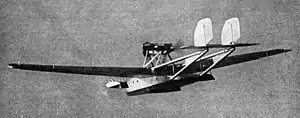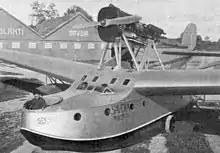| Savoia-Marchetti S.63 | |
|---|---|
 | |
| Role | Flying boat bomber and airliner |
| National origin | Italy |
| Manufacturer | Savoia-Marchetti |
| First flight | 8 September 1927 |
| Number built | 1 |
The Savoia-Marchetti S.63 was a single hull development of the Italian Savoia-Marchetti S.55 flying boat. It first flew as a bomber in 1927 but was rapidly converted into an airliner. The only S.63 built served with an Italian airline.
Design and development

Savoia-Marchetti's earlier and very successful S.55 flying boat had been designed as a torpedo bomber, leading to the use of a twin hull. It could carry passengers and make long distance flights but its hulls added drag and weight, making take-offs with large fuel loads challenging. The S.63 differed primarily in having a single hull[1] and was originally built as a bomber.[2] However, after service trials in 1927 it was decided that it did not offer any great advantage over the S.55, so it was converted into a ten-passenger airliner.
The S.63 was a cantilever high wing monoplane with a three-part, thick profile wing which thinned outwards; at its thickest, the centre-section was 900 mm (35.4 in) deep. The outer panels were trapezoidal in plan and set with about 6° of dihedral. They carried short, overhung, tapered ailerons near the tips. The wing was a wooden structure, with three spars. Its leading edge was covered with plywood, the rest with fabric.[1]
The S.63 was powered by a push-pull pair of 370 kW (500 hp) water-cooled Isotta Fraschini Asso 500 V-12 engines. These were mounted high above the wing centre on inward-leaning pairs of N-struts and a pair of central transverse V-struts, canted strongly upwards and uncowled to reduce fire risk. They shared a single, forward-mounted honeycomb radiator and an oil tank positioned between them.[1]
The earlier S.55 carried its empennage on a pair of open, flat, triangular girders constructed from tubes, one from each hull. The S.63 used a similar arrangement, allowing its single, unusually wide hull to be short. Its bottom had a shallow, concave V-section and a single step. Lateral stability on the water was provided by outward-leaning, V-bottomed floats mounted a little outside the centre-section. The original bomber version had defensive ring-mounted machine gun positions in the nose and behind the trailing edge. A forward entrance led to the pilots' side-by-side open cockpit, offset to the left and ahead of the wing leading edge.[1] The airliner conversion separated the pilots into two symmetrically positioned, enclosed cockpits[3] and introduced a windowed 3 m × 3 m (9 ft 10 in × 9 ft 10 in) passenger cabin behind the cockpit which seated ten. Behind it there was a space for luggage and a wireless operator's compartment with access to the engines.[1]
The empennages of the S.55 and S.63 were similar, though the latter had two vertical tails rather than three. These were wire-braced and, including balanced rudders, quadrantal in profile, with one attached to each girder. A rectangular tailplane, mounted at a high incidence, linked the girders and projected beyond them. It carried a semi-elliptical, balanced elevator.[1]
Operational history
The first flight of the S.63 was on 8 September 1927.[3] By March 1928 Alandresso Passaleva had completed sufficient testing to report excellent characteristics.[1] Registered as I-AABH, it was bought by Società Aerea Mediterranea (SAM) airline and used on the Rome-Cagliari route along with their S.55s.[3]
Operators
- Italy
Specifications

Data from Les Ailes, March 1928[1]
General characteristics
- Crew: 4 (bomber version)
- Capacity: 10 passengers
- Length: 15.50 m (50 ft 10 in)
- Wingspan: 27 m (88 ft 7 in)
- Height: 5 m (16 ft 5 in)
- Wing area: 105 m2 (1,130 sq ft)
- Empty weight: 3,900 kg (8,598 lb)
- Gross weight: 6,100 kg (13,448 lb) with normal (2,200 kg (4,900 lb)) useful load
- Max takeoff weight: 6,900 kg (15,212 lb)
- Powerplant: 2 × Isotta Fraschini Asso 500 water-cooled V-12, 370 kW (500 hp) each (nominal)
- Propellers: 2-bladed
Performance
- Maximum speed: 210 km/h (130 mph, 110 kn)
- Cruise speed: 170 km/h (110 mph, 92 kn)
- Stall speed: 100 km/h (62 mph, 54 kn) minimum speed
- Time to altitude: 40 min to 2,000 m (6,600 ft)
- Fuel consumption: 0.85 kg/km (3.0 lb/mi)
References
- 1 2 3 4 5 6 7 8 Serryer, J. (1 March 1928). "L'hydravion Savoia-Marchetti S-63". Les Ailes (350): 6.
- ↑ "L'hydravion Savoia-Marchetti S 63, de grand bombardment". L'Aérophile. 36 (7–8): 119. 1–15 April 1928.
- 1 2 3 Bignozzi, Giorgio; Gentilli, Roberto (1982). Aeroplani S.I.A.I : 1915-1935. Firenze: Edizioni Aeronautiche Italiane. p. 79.